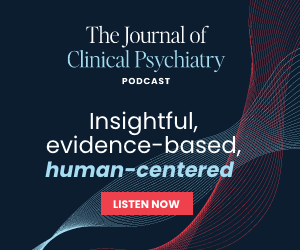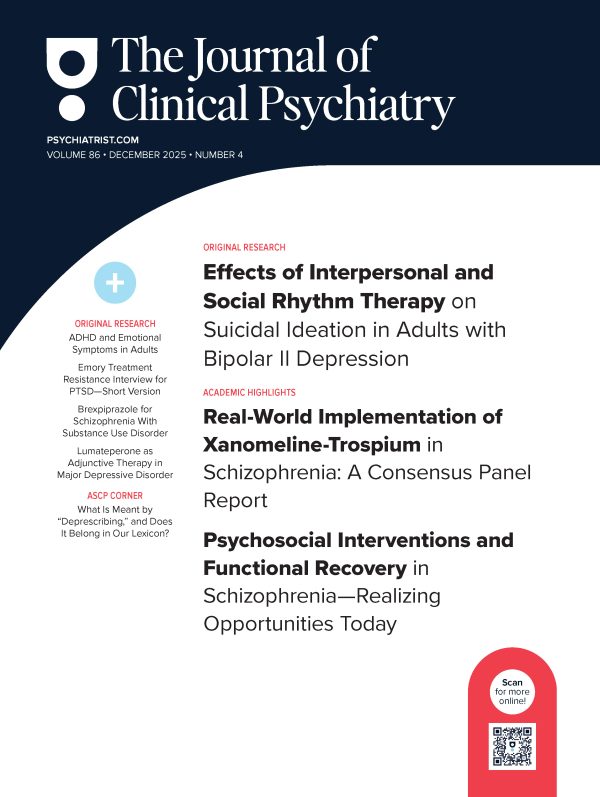ABSTRACT
Objective: To evaluate the relationship between medications used to treat acute agitation (antipsychotics, mood stabilizers, and benzodiazepines) and subsequent assault incidence in the psychiatric emergency department.
Methods: Medication orders and assault incident reports were obtained from electronic health records for 17,056 visits to an urban psychiatric emergency department from 2014 to 2019. Assault risk was modeled longitudinally using Poisson mixed-effects regression.
Results: Assaults were reported during 0.5% of visits. Intramuscular (IM) medications were ordered in 23.3% of visits overall and predominantly were ordered within the first 4 hours of a visit. IM medication orders were correlated with assault (incident rate ratio [IRR] = 24.2; 95% CI, 5.33–110.0), often because IM medications were ordered immediately subsequent to reported assaults. Interacted with time, IM medications were not significantly associated with reduction in subsequent assaults (IRR = 0.700; 95% CI, 0.467–1.04). Neither benzodiazepines nor mood stabilizers were associated with subsequent changes to the risk of reported assault. By contrast, antipsychotic medications were associated with decreased assault risk across time (IRR = 0.583; 95% CI, 0.360–0.942).
Conclusions: Although assault prevention is not the sole reason for ordering IM medications, IM medication order rates are high relative to overall assault incident risk. Of the 3 major categories of medications ordered commonly in the psychiatric emergency setting, only antipsychotic medications were associated with measurable decreases in subsequent assault risk. As antipsychotic medication can have a significant side effect burden, careful weighing of the risks and benefits of medications is encouraged.
Members Only Content
This full article is available exclusively to Professional tier members. Subscribe now to unlock the HTML version and gain unlimited access to our entire library plus all PDFs. If you’re already a subscriber, please log in below to continue reading.
References (35)

- Binder RL, McNiel DE. Emergency psychiatry: contemporary practices in managing acutely violent patients in 20 psychiatric emergency rooms. Psychiatr Serv. 1999;50(12):1553–1554. PubMed CrossRef
- Sullivan C, Yuan C. Workplace assaults on minority health and mental health care workers in Los Angeles. Am J Public Health. 1995;85(7):1011–1014. PubMed CrossRef
- Sullivan C, Yuan C. Workplace assaults on minority health and mental health care workers in Los Angeles. Am J Public Health. 1995;85(7):1011–1014. PubMed CrossRef
- Sanghani SN, Marsh AN, John M, et al. Characteristics of patients involved in physical assault in an acute inpatient psychiatric setting. J Psychiatr Pract. 2017;23(4):260–269. PubMed CrossRef
- The Joint Commission. Physical and verbal violence against health care workers. Available at: https://www.jointcommission.org/-/media/tjc/idev-imports/topics-assets/workplace-violence-prevention-implementing-strategies-for-safer-healthcare-organizations/sea_59_workplace_violence_4_13_18_finalpdf.pdf. Cited Feb 18, 2021.
- Biancosino B, Delmonte S, Grassi L, et al; PROGRES-Acute Group. Violent behavior in acute psychiatric inpatient facilities: a national survey in Italy. J Nerv Ment Dis. 2009;197(10):772–782. PubMed CrossRef
- Raja M, Azzoni A, Lubich L. Aggressive and violent behavior in a population of psychiatric inpatients. Soc Psychiatry Psychiatr Epidemiol. 1997;32(7):428–434. PubMed
- Iozzino L, Ferrari C, Large M, et al. Prevalence and risk factors of violence by psychiatric acute inpatients: a systematic review and meta-analysis. PLoS One. 2015;10(6):e0128536. PubMed CrossRef
- Edwards JG, Jones D, Reid WH, et al. Physical assaults in a psychiatric unit of a general hospital. Am J Psychiatry. 1988;145(12):1568–1571. PubMed CrossRef
- Grassi L, Peron L, Marangoni C, et al. Characteristics of violent behaviour in acute psychiatric in-patients: a 5-year Italian study. Acta Psychiatr Scand. 2001;104(4):273–279. PubMed CrossRef
- Soliman AE, Reza H. Risk factors and correlates of violence among acutely ill adult psychiatric inpatients. Psychiatr Serv. 2001;52(1):75–80. PubMed CrossRef
- Lehmann LS, McCormick RA, Kizer KW. A survey of assaultive behavior in Veterans Health Administration facilities. Psychiatr Serv. 1999;50(3):384–389. PubMed CrossRef
- Krakowski M, Czobor P. Gender differences in violent behaviors: relationship to clinical symptoms and psychosocial factors. Am J Psychiatry. 2004;161(3):459–465. PubMed CrossRef
- Hillbrand M, Foster HG, Spitz RT. Characteristics and cost of staff injuries in a forensic hospital. Psychiatr Serv. 1996;47(10):1123–1125. PubMed CrossRef
- Cornaggia CM, Beghi M, Pavone F, et al. Aggression in psychiatry wards: a systematic review. Psychiatry Res. 2011;189(1):10–20. PubMed CrossRef
- Goedhard LE, Stolker JJ, Heerdink ER, et al. Pharmacotherapy for the treatment of aggressive behavior in general adult psychiatry: a systematic review. J Clin Psychiatry. 2006;67(7):1013–1024. PubMed CrossRef
- Lam JN, McNiel DE, Binder RL. The relationship between patients’ gender and violence leading to staff injuries. Psychiatr Serv. 2000;51(9):1167–1170. PubMed CrossRef
- Dietz PE, Rada RT. Battery incidents and batterers in a maximum security hospital. Arch Gen Psychiatry. 1982;39(1):31–34. PubMed CrossRef
- Owen C, Tarantello C, Jones M, et al. Violence and aggression in psychiatric units. Psychiatr Serv. 1998;49(11):1452–1457. PubMed CrossRef
- Ketelsen R, Zechert C, Driessen M, et al. Characteristics of aggression in a German psychiatric hospital and predictors of patients at risk. J Psychiatr Ment Health Nurs. 2007;14(1):92–99. PubMed CrossRef
- Stowell KR, Hughes NP, Rozel JS. Violence in the emergency department. Psychiatr Clin North Am. 2016;39(4):557–566. PubMed CrossRef
- Lawrence RE, Rolin SA, Looney DV, et al. Physical assault in the psychiatry emergency room. J Am Acad Psychiatry Law. 2020;48(4):484–495. PubMed
- Hedeker DR, Gibbons RD. Longitudinal Data Analysis. Hoboken, NJ: Wiley-Interscience; 2006.
- Ball R, Brown P. An empirical evaluation of accounting income numbers. J Account Res. 1968;6(2):159. CrossRef
- Amore M, Menchetti M, Tonti C, et al. Predictors of violent behavior among acute psychiatric patients: clinical study. Psychiatry Clin Neurosci. 2008;62(3):247–255. PubMed CrossRef
- Lavelle S, Tusaie KR. Reflecting on forced medication. Issues Ment Health Nurs. 2011;32(5):274–278. PubMed CrossRef
- Georgieva I, Mulder CL, Wierdsma A. Patients’ preference and experiences of forced medication and seclusion. Psychiatr Q. 2012;83(1):1–13. PubMed CrossRef
- Hankin CS, Bronstone A, Koran LM. Agitation in the inpatient psychiatric setting: a review of clinical presentation, burden, and treatment. J Psychiatr Pract. 2011;17(3):170–185. PubMed CrossRef
- Bowden CL, Brugger AM, Swann AC, et al; The Depakote Mania Study Group. Efficacy of divalproex vs lithium and placebo in the treatment of mania. JAMA. 1994;271(12):918–924. PubMed CrossRef
- Simpson SA, Joesch JM, West II, et al. Risk for physical restraint or seclusion in the psychiatric emergency service (PES). Gen Hosp Psychiatry. 2014;36(1):113–118. PubMed CrossRef
- Arnetz JE, Hamblin L, Ager J, et al. Underreporting of workplace violence: comparison of self-report and actual documentation of hospital incidents. Workplace Health Saf. 2015;63(5):200–210. PubMed CrossRef
- Sarver WL, Radziewicz R, Coyne G, et al. Implementation of the brøset violence checklist on an acute psychiatric unit. J Am Psychiatr Nurses Assoc. 2019;25(6):476–486. PubMed CrossRef
- Anderson KK, Jenson CE. Violence risk-assessment screening tools for acute care mental health settings: literature review. Arch Psychiatr Nurs. 2019;33(1):112–119. PubMed CrossRef
- Chang G, Weiss AP, Orav EJ, et al. Hospital variability in emergency department length of stay for adult patients receiving psychiatric consultation: a prospective study. Ann Emerg Med. 2011;58(2):127–136.e1. PubMed CrossRef
- Zhu JM, Singhal A, Hsia RY. Emergency department length-of-stay for psychiatric visits was significantly longer than for nonpsychiatric visits, 2002–11. Health Aff (Millwood). 2016;35(9):1698–1706. PubMed CrossRef






